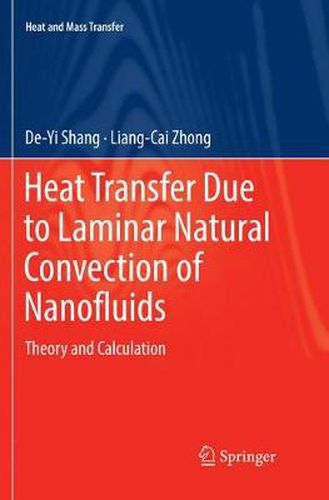Readings Newsletter
Become a Readings Member to make your shopping experience even easier.
Sign in or sign up for free!
You’re not far away from qualifying for FREE standard shipping within Australia
You’ve qualified for FREE standard shipping within Australia
The cart is loading…






This title is printed to order. This book may have been self-published. If so, we cannot guarantee the quality of the content. In the main most books will have gone through the editing process however some may not. We therefore suggest that you be aware of this before ordering this book. If in doubt check either the author or publisher’s details as we are unable to accept any returns unless they are faulty. Please contact us if you have any questions.
This book presents a theoretical study of heat transfer due to laminar natural convection of nanofluids, using Al2O3-water nanofluid as an example. An innovative method of similarity transformation of velocity fields on laminar boundary layers is applied for the development of a mathematical governing model of natural convection with actual nanofluids, and a novel model of the nanofluid’s variable thermophysical properties is derived by a mathematical analysis based on the developed model of variable physical properties of fluids combined with the model of the nanofluid’s thermal conductivity and viscosity. Based on these, the physical property factors of nanofluids are produced, which leads to a simultaneous solution for deep investigations of hydrodynamics and heat transfer of nanofluid’s natural convection.
The book also proposes novel predictive formulae for the evaluation of heat transfer of Al2O3-water nanofluid’s natural convection. The formulae have reliable theoretical and practical value because they are developed by rigorous theoretical analysis of heat transfer combined with full consideration of the effects of the temperature-dependent physical properties of nanofluids and the nanoparticle shape factor and concentration, as well as variations of fluid boundary temperatures. The conversion factors proposed help to turn the heat transfer coefficient and rate of fluid natural convection into those of nanofluid natural convection. Furthermore, several calculation examples are provided to demonstrate the heat transfer application of the proposed predictive formulae.
$9.00 standard shipping within Australia
FREE standard shipping within Australia for orders over $100.00
Express & International shipping calculated at checkout
This title is printed to order. This book may have been self-published. If so, we cannot guarantee the quality of the content. In the main most books will have gone through the editing process however some may not. We therefore suggest that you be aware of this before ordering this book. If in doubt check either the author or publisher’s details as we are unable to accept any returns unless they are faulty. Please contact us if you have any questions.
This book presents a theoretical study of heat transfer due to laminar natural convection of nanofluids, using Al2O3-water nanofluid as an example. An innovative method of similarity transformation of velocity fields on laminar boundary layers is applied for the development of a mathematical governing model of natural convection with actual nanofluids, and a novel model of the nanofluid’s variable thermophysical properties is derived by a mathematical analysis based on the developed model of variable physical properties of fluids combined with the model of the nanofluid’s thermal conductivity and viscosity. Based on these, the physical property factors of nanofluids are produced, which leads to a simultaneous solution for deep investigations of hydrodynamics and heat transfer of nanofluid’s natural convection.
The book also proposes novel predictive formulae for the evaluation of heat transfer of Al2O3-water nanofluid’s natural convection. The formulae have reliable theoretical and practical value because they are developed by rigorous theoretical analysis of heat transfer combined with full consideration of the effects of the temperature-dependent physical properties of nanofluids and the nanoparticle shape factor and concentration, as well as variations of fluid boundary temperatures. The conversion factors proposed help to turn the heat transfer coefficient and rate of fluid natural convection into those of nanofluid natural convection. Furthermore, several calculation examples are provided to demonstrate the heat transfer application of the proposed predictive formulae.